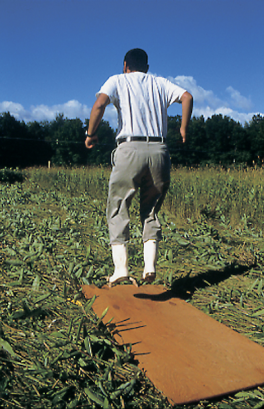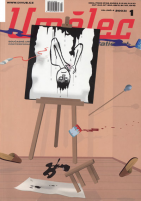| Umělec magazine 2003/1 >> Advice From a Poor Relative | List of all editions. | ||||||||||||
|
|||||||||||||
Advice From a Poor RelativeUmělec magazine 2003/101.01.2003 David Kulhánek | profile | en cs |
|||||||||||||
|
"Daniel Bozhkov moved to the USA from his native Bulgaria in the early 1990s. Like many other artists from the Eastern Bloc, he took advantage of the open border to go taste what had been forbidden fruit. In many respects even today he is still the same poor relative from the East, an artist with an academic education in the techniques of wall painting who left to see the world. He looks around and grafts his critical view onto everyday reality. He is fascinated by “the new world.” He’s bewitched by New York and America — as a “place where the stereotypes of the contemporary world are constituted.” He found himself at the source of energy that nourished the narcissistic vision of Western civilization. His outsider strategy celebrates slow success …
In January of this year Bozhkov exhibited in Gallery Andrew Kreps in Chelsea in New York his new project with the tongue-twisting title Learning How to Fly Over a Very Large Larry. In the summer of 2002 he put on an absurd set of actions, which in the end were enriched by his gallery presentation. Watchers of CNN know Larry King as a good-natured guy with colorful suspenders. Almost every day he and his viewers are able to get under the skin of the guests he invites to his studio. Viewer ratings at the same time feed King’s private business. Larry embodies the magical power of an interpreter of the masses. He is the one who monitors what is happening, who knows about everything and at just the right moment asks the perfectly aimed and informed question. The infallible glossator and almost “renaissance” man of today. What exactly did Bozhkov do? He attempted to bring movement to this stereotypical situation — opened it into unexpected facets. In some kind of state of confused humility, he decided to create a giant portrait of the television wizard on a friend’s property in the state of Maine. The large-format “drawing” in the field was timed so that its completion would collide with the premier of the film Signs. He dedicated the portrait to King, not personally, but only by announcing its creation to the editorial staff. And then he waited for a response, which actually came. In one of his programs Larry suddenly looked away from his guest directly at the camera and with unfeigned modesty began a remarkable story from his private life: “Now this is a new one here. One artist has decided to create my portrait, but this is not just any old thing. Come with me and let’s see what it looks like.” The following few seconds are an overhead airplane shot of a field, stamped down into the shape of King’s head. The goal had been reached: he had established contact during live broadcast and also baffled the minds of the viewers and the television wizard himself. But this is only one level of the project. The entire action was documented on video — the artist furrowing the corn field with a rectangular plank. The portrait is also shot from an airplane. Bozhkov had to invest in a flight training course in order to do it and the result of his project was that he could even fly over his own picture under his own power. Back down on the earth he made contact with a local village girl, who, he unexpectedly found out, had never heard of King. The girl was asked to describe in detail every kind of weed growing in the incriminating field. Then he exhibited in the exhibition an herbarium with a stamped logo of Larry’s face. Other parts of the galley installation were a sofa and monitor with a recording of the action, the airplane shots and the recording of Larry’s commentary. In addition, there were pictures with themes of the artist during his work on the portrait, as well as the plank he used to make the portrait. Bozhkov managed to create an improbable constellation of relationships and carried this absurd ensemble over into the gallery. The whole thing looks at moments like some kind of action caricature, as well as a subversive probe into media reality. Bozhkov’s older project, but which he plans to continue, works with a similar blend of seemingly gullible naivete and “home-made” social criticism. Bozhkov let himself be employed as the “poor relative” in the department store Walmart — one of the 3,500 branches of the biggest American chain retail store. Within this consumer paradise you can find the function of the official “welcomer,” who personally congratulates every visitor on his or her entry to the shop — a job Bozhkov performed for a few months. He titled his project Training in Assertive Hospitality. He experienced the miracle of manipulating consumers and facilitating their (and his own) “entry into the system.” At the same time he attained permission to make a wall painting in the back area of the store. In August 2003 the artist is getting ready to once again be employed as a welcomer and to invite a well-known Italian restorer to touch up the previously mentioned painting. His presence in the context of “emblematic” Walmart finds itself outside the horizons of probable behavior. Bozhkov is a “humble” mascot and creator of critical probes. Other projects under way bring together the real world of scientific research and the obscure-looking theory about the uniqueness of the gene pool of Bulgarians. It has been proven that nearly one tenth of the Bulgarian population has a predisposition for long life thanks to their consumption of yogurt, which contains a special kind of bacteria called lactobaribus bulgaricus. The goal of the project is to make yogurt enriched with human DNA, which the yogurt bacteria would be capable of reproducing. Bozhkov has offered his own blood, with wide genetic information to be extracted from the white blood cells. This phantasmagoric sounding project is part of a series in this scientific objective to which a whole team of scientists at the prestigious Sloan-Kettering Institute in New York is dedicated. The results of the research will be revealed over the next several years; Bozhkov is still available as a life source. In the meantime he is presenting only the cups with his portrait and (to date) with the imaginary contents of the product. The experiment is called Be a Friend of Bac-teria. The allusion to the obsession with health food and “fitness” of all types is clear. The creation of new cultures of bacteria with Bulgarian DNA is a parody of “genetic optimism,” with the serious danger that the vision may become reality. The border between fiction and reality is largely uncertain. Daniel Bozhkov is a “surfer” with the appearance of an orthodox pope. His slippery movement across hierarchy and intervention into various social relationships have a decidedly low-tech profile. There is the flashy power of being the outsider, which has an effect. "
01.01.2003
Recommended articles
|
|||||||||||||








Comments
There are currently no comments.Add new comment